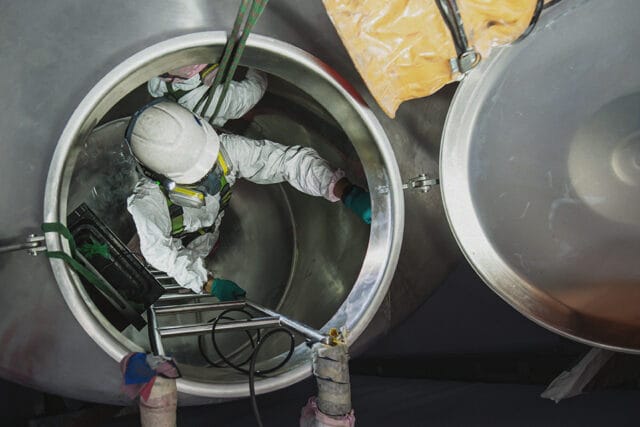
Process Safety Management: 3 Steps for Improvement
Companies should consider implementing these three steps to improve their process safety management and create a better working environment.

When the US Occupational Safety and Health Administration (OSHA) announced the Process Safety Management (PSM) Standard 29 CFR 1910.119, it came with a mandate that a management system comprising several well-defined elements be established “for preventing or minimizing the consequences of catastrophic releases of toxic, reactive, flammable or explosive chemicals.” The process safety information (PSI) element of the PSM rule states, “The employer shall document that equipment complies with recognized and generally accepted good engineering practices,” with specific reference given to “relief system design and design basis.”
OSHA does not explicitly use the term “continuously improving” in its regulatory standards. However, it does use equivalent words such as “accurate, complete, clear, and ongoing.” One example is Appendix C compliance guidelines of 29 CFR 1910.119, which uses “complete and accurate” instead of “continually improving.” Likewise, for the mechanical integrity element of 29 CFR 1910.119, OSHA uses the term “ongoing” to describe the expectation to improve continually.
1. Incorporating the CDC’s Prevention Through Design
According to the Centers for Disease Control and Prevention (CDC) website, Prevention through Design (PtD) seeks to “prevent or reduce occupational injuries, illnesses, and fatalities through the inclusion of prevention considerations in all designs that impact workers.”
“Designing out” occupational hazards and risks is the most effective way to protect workers. Without a doubt, PtD’s mission dovetails with the high standards for initial design and continuous improvement required by PSM operators. It should be integral to designing and writing programs and procedures for a PSM facility.
PtD is most suited for the Process Safety Management design process at the beginning of a PDM facility project. Stakeholders, skilled engineers, and safety professionals should come together to discuss the system components. They should identify any potential issues or flaws that could cause a hazard when the plant begins operations. PtD cannot predict future issues or upgrades. However, conducting PtD design reviews gives a PSM facility room to improve as the regulatory environment and new technologies develop.
Process Safety Management regulations and formal management systems created by individual companies have sometimes been in place for over 20 years. Companies find it difficult to continuously improve their PSM system. Resource limitations, poor management system audit outcomes, and stagnant process safety incident performance are the reasons. Despite this, perceived benefits include reduced major accident risk and improved chemical industry performance.
2. Leveraging a Process Hazard Analysis
Continuous improvement can address performance issues or efficiency issues, or both. Companies should continuously seek new ways to improve PSM activities using a programmed, specific process for evaluating such a Process Hazard Analysis (PHA).
OSHA describes the performance of a PHA as a “careful review” that considers potential issues and the necessary safeguards to prevent hazardous chemical release. PSM includes PHA, so PSM owners must evaluate the parts of PSM that present the most significant risk.
Companies must perform the PHA to identify, evaluate, and control the parts of the process systems involving highly hazardous chemicals. As with PtD, a PHA should look at safeguards already designed into the processing system and identify areas where risks pose concerns and are unacceptable.
Therefore, continuous improvement is a given. Note that the end goal of performing any PtD review during design or periodic PHAs is not to label a process as “safe” but to detect unprotected situations and trigger the necessary safety improvements to reduce or minimize risk.
Challenges to Continuous Improvement
The Process Safety Management requirement of continuous improvement continues to challenge many organizations for several reasons, including the following:
- Resource pressures
- Inadequate safety oversight and expertise
- A lack of adequate or sparingly produced audit results
- Failure to take an active stance on safety incident investigation, review, and the improvement of post-incident performance
The truth is that most companies claim to advocate for continuous Improvement of their PSM program and associated equipment and systems. Still, few put any substance to the words and requirements of the PSM written programs and procedures, and – resultantly – succeed in practice.
3. Creating a Process Safety Management Game Plan
What is your plan for continuous improvement if you are a safety professional in charge of compliance, risk assessment, and management of one or more PSM facilities? Here are some practical tips:
- Promote meetings and scheduled reviews such that engineers, designers, safety professionals, management, and other stakeholders can gather together and workshop how to safely prepare the PSM plant components for maintenance, large-scale plant turnarounds, inspections, or engineering intervention.
- Ensure all stakeholders have access to the correct process safety engineering information. Learning from previous designs and improvements can be onerous if documentation and organization are incomplete and real-time operational status remains untracked.
- Agree with all stakeholders (especially management and operators) that control and shut down operations must comply with regulatory requirements but also occur when noting the slightest intuition of faults in the PSM system or potential risk.
- Information about potential hazards of chemicals, processes, technology, and equipment must be readily available to everyone in the facility, especially the line-level workers, who must be able to make decisions under pressure at a moment’s notice.
These tips serve as a baseline for the PHA, ongoing hazard analysis, and risk assessment process in PSM facilities. The documents containing the original design and documentation of every continuous improvement measure must be comprehensive. This information must be sufficient for any upgrade work, ongoing operations, and maintenance.
Audit results that find incompleteness or flaws in the documentation must be discovered quickly. These pose a risk and should be integrated into the institutional knowledge database.
Excellent Process Safety Management Requires the Right Solutions
Managing a Process Safety Management Program can be daunting for businesses. Many organizations experience flaws and pitfalls in designing and continuously improving their system. Fortunately, Veriforce can help companies navigate the complexities of PSM compliance, from initial design to audit performance and follow-up.
As an experienced Process Safety Management consultant, I have seen the benefits of working with knowledgeable colleagues or trusted consulting experts, like Veriforce, to ensure the safest and most effective PSM program possible.




